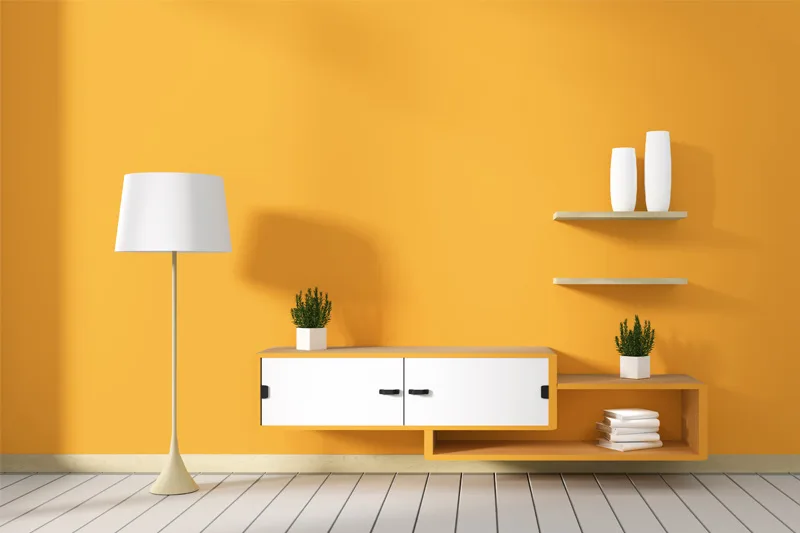Have you ever wondered why you feel relaxed and comfortable in one space and tense or angry in another? It might be due to the room color.
Yes, you heard it right! research has found that more than a visual experience, room color has a psychological effect that can radically affect one’s mood and emotion on an unconscious level. Therefore, when choosing a color scheme for your home, make sure that you have picked the right colors for each room. Expert home interior designers in Trivandrum know that room color psychology is an integral part of one’s daily life, and they can help you choose the right color for each room.

- Room colors not only impact our moods and our thoughts but also serve as a direct reflection of our personality. You can create a very specific mood for each room by simply choosing right color for your walls, furniture, or even by enhancing the room with throw pillows, a blanket, plants or a picture on the wall. Overall, color has the power to change the shape and size of furnishings as well as the shape and size of the room itself. The key is to select colors that reflect your preferences and personality.
When choosing a color for your room, ask yourself certain questions like what mood do you want to create in your room and what colors match that mood. Choosing colors for your rooms is not that difficult if you equip yourself with some basic information about color and its effects. Here’s a color guide that points out which color would suit a room or area of a home:
- Office RoomsBlue is the perfect hue for an office room as it is considered the most productive color. In fact, researchers at Creighton University found that when employees worked in blue-colored offices, they felt more centered, calm, and hopeful towards their work and made fewer mistakes than working in a white office. Blue also lowers your heart rate and evokes wisdom. Avoid shades of gray for an office as it is a passive color that lacks the energy.
- BedroomThe bedroom is a place of peace and relaxation. Therefore, the colors you choose for your bedroom should bring peace and restfulness to the space.
Colors such as green, blue and purple (lavender) are ideal options for your bedroom as they are known for their relaxing qualities. Of these three, green is a great choice, as it relieves stress and help with fertility. Blue represents calm, trustworthiness and strength. It is also said to lower one’s blood pressure while slowing respiration and heart rate. Lavender is the most popular choice as it calms the nerves and promotes relaxation. Try to avoid orange and pastel blue in your bedroom.
- A Girl’s RoomConsidered a feminine color, pink suits a girl’s room perfectly as it represents calm and warmth. Though pink is a tint of red, it still has the cheerfulness of a warm color that can have a positive effect on mood.
- KitchenYellow is the best color for kitchen as it’s cheerful, brings an energizing vibe and can help increase metabolism. Besides yellow, you can also use gray and green for your kitchen. Gray is simple yet elegant and goes with any other color. If you choose gray for your kitchen, try to accentuate it with other warm colors. Green is also a great option as it is the color of nature which can make you feel grounded, relaxed and naturally energized. Avoid lime green or a dull pea green. Never choose black and brown for your kitchen as these colors are too sharp.
- Living RoomFor a calm and relaxed living room, choose the beautiful, calming shade of lavender. It can calm nerves, and promote serenity and mindfulness. Try adding a few darker purple accents, like cushions or paintings, to your living room.
Blue and green are other two options you could consider as these hues also promote calm and coolness to your living space. Choose either a light pastel blue or a darker blue, but not a navy blue. Also try to avoid orange in your living room, as it is too energetic to promote relaxation.
- Dining RoomFor your dining room, choose colors that promote appetite. Red is a color that stimulates appetite, which makes it a good match for a dining room. It also draws people together and stimulates conversation. You can also consider yellow – which can add positive energy and happy vibes, as well as increase hunger – and purple – it brings excitement and luxury.
However, there are some colors that have actually been proven to make people feel less hungry. For instance, blue can make you feel sleepy and reduce your appetite. Green, especially bright green hues, can also energizes you and leave you less inclined to eat.
When you are planning the color scheme for a new home or repainting your existing home, it would be very useful to know what colors enhance which emotions. However, remember that too many colors can make a room feel chaotic or cluttered, so choose happy, positive, and encourage colors for your home. Make it a space that brings out the very best in you and your family. If you are still confused with the psychology of room colors, you can rely on experienced interior designers in Trivandrum to make an informed decision on room colors.

